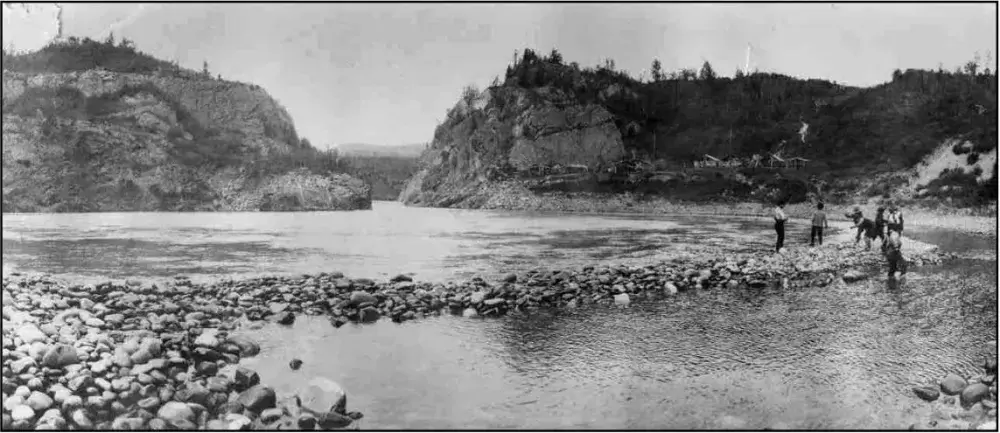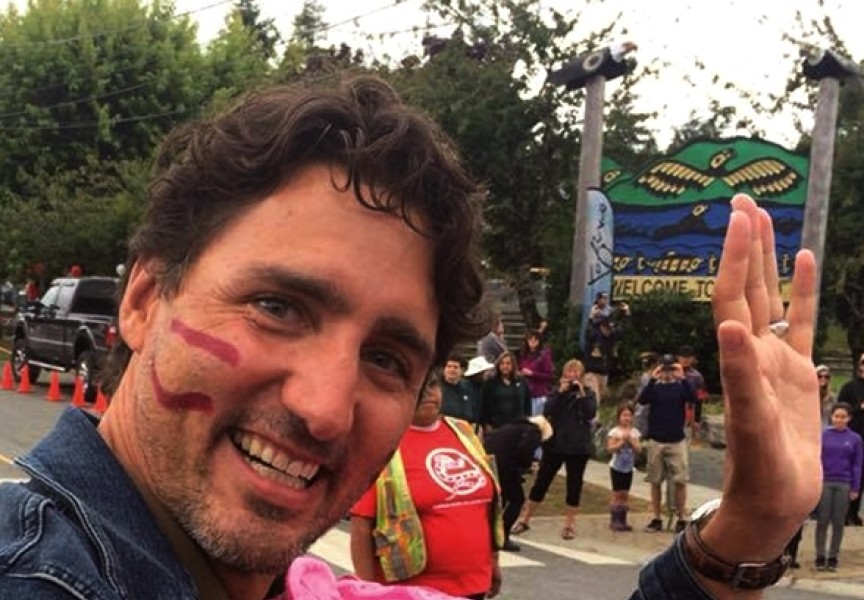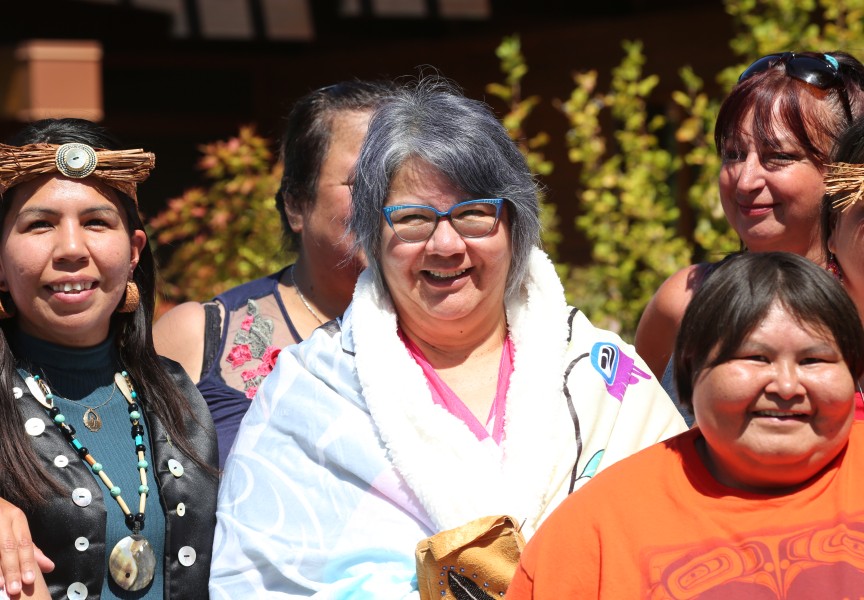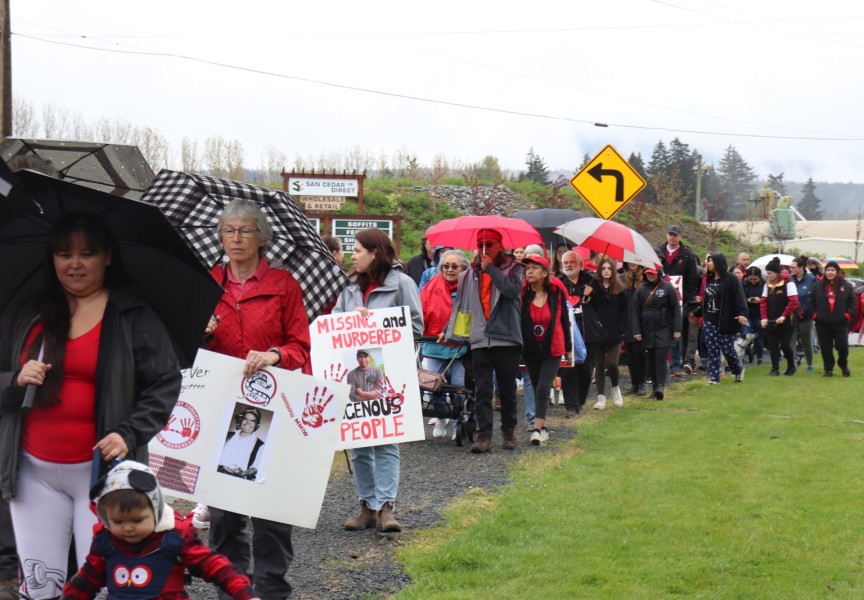Prime Minister Justin Trudeau delivered a hard stance on the continued opposition to the Coastal GasLink pipeline in central B.C., announcing that “the barricades must come down, the injunctions must be obeyed and the law must be upheld” at a press conference today.
But shortly after this statement, a Wet’suwet’en hereditary chief stressed that a peaceful resolution won’t be possible until the RCMP leave their land.
After two weeks of rail and road barricades in solidarity with a group of Wet’suwet’en hereditary chiefs – and cross-country protests against the planned natural gas pipeline through their territory – Trudeau indicated that the conflict has reached a point where negotiations are no longer productive.
“Every attempt at dialogue has been made,” he said. “The discussions have not been productive. You can’t have dialogue when only one party is coming to the table. For this reason, we have no choice but to stop making the same overtures.”
An hour later Chief Woos (Frank Alec) held his own press conference on behalf of the nation’s hereditary chiefs, saying that nation-to-nation discussions with the provincial and federal government can occur on Wet’suwet’en land – but only if the police honour an eviction notice the chiefs issued Jan. 4.
The chiefs demand “that the RCMP are completely removed from our territory and cease patrols of our lands,” said Woos. “Out means out.”
Enforcement of court injunctions against blockades could lead to more arrests, bringing the possibility of deepening divisions that have cut into communities across the country. When RCMP moved into Wet’suwet’en territory on Feb. 6 to enforce a court order, their arrests set off a series of rail blockades and protests across Canada that many believe have put the country’s distribution system on the verge of a crisis. Railway shutdowns in multiple regions led VIA to send almost 1,000 people off the job, while CN has announced 450 layoffs.
At stake is the future of a 670-kilometre natural gas pipeline that would extend from near Dawson Creek to Kitimat, where the gas would be liquified for export overseas. At least 20 First Nations along this route have signed benefit agreements with the company – including five of the six elected band councils in Wet’suwet’en territory – but for years a group of the nation’s hereditary chiefs have been opposed to the route.
Everything is connected to the land
The Wet’suwet’en “do not see themselves as entities separate from nature or their territories,” according to a 2014 submission from the nation’s hereditary chiefs to the B.C. Environmental Assessment Office.
Following the principle of “yintahk,” which means everything is connected to the land, this belief was used by the Office of the Wet’suwet’en to explain why the nation’s hereditary chiefs oppose the construction of the natural gas pipeline through 190 kilometres of their territory.
“The Wet’suwet’en do not merely live on the land, they are part of the land, they belong to it and they return to it,” wrote the office of the hereditary chiefs.
Despite the support of most of the elected councils in the 22,000 square kilometres of territory, the hereditary chiefs have remained unconvinced that the pipeline won’t cause irreparable harm to their land and the salmon-bearing Skeena watershed.
“Hereditary chiefs are entrusted with the stewardship of territories by virtue of the hereditary name they hold, and they are the caretakers of these territories for as long as they hold the name,” continued their submission to the EAO. “It is the task of a head chief to ensure the house territory is managed in a responsible manner, so that the territory will always produce enough game, fish, berries and medicines to support the subsistence, trade, and customary needs of house members.”
This position has gained support from Nuu-chah-nulth leaders, including Ahousaht Tyee Ha’wilth Maquinna (Lewis George).
“What they want to do on their owns lands is their business,” he said during a recent Council of Ha’wiih Forum on Fisheries in Campbell River. “The Wet’suwet’en today, the hereditary chiefs, Ahousaht stands in solidarity with them.”
Nuu-chah-nulth Tribal Council President Judith Sayers stressed her support in a release issued Feb. 11.
“We stand with the Wet’suwet’en in protecting their lands, waters and resources from development of gas pipelines,” reads the NTC statement. “We stand with the supporters of the defenders of the land across this country, especially our youth.”
Chiefs’ alternative route was rejected
Although it opposes the Coastal GasLink route, the Office of the Wet’suwet’en has stated that the chiefs are not against a pipeline going through their territory. In 2014 the group of hereditary chiefs proposed an alternative route that would run along land that has already been disturbed by industrial development.
Citing years of study, Coastal GasLink rejected these alternatives due to a combination of additional pipeline expense, environmental risk, hazardous terrain and the proposed route’s vicinity to towns.
A recent B.C. Supreme Court Injunction ordering the removal of a blockade in the way of Coastal GasLink construction on Wet’suwet’en land noted the reasons for not proceeding with the hereditary chiefs’ alternative.
“The plaintiff explored and considered the proposed alternate route but ultimately rejected it for various reasons, including inappropriateness for the diameter of the pipeline, increased cost, the desire to avoid urban areas and greater adverse environmental impacts,” wrote Justice Marguerite Church in her injunction.
‘Economic reconciliation’ hangs in the balance
While the Wet’suwet’en hereditary chiefs are steadfast in protecting their territory, other First Nations have put a high emphasis on Coastal GasLink and its connecting LNG Canada terminal to bring their communities out of poverty. The terminal would be built on the territory of the Haisla Nation, which plans to see employment and training benefits from the project.
Chief Councillor Crystal Smith said the development has already funded community programs for her nation. Smith is also chair of the First Nations LNG Alliance.
“It’s through economic development, economic reconciliation, that we’re going to find the path back to our true identities, and revitalizing our culture as Indigenous people,” she said during the BC Natural Resources Forum in Prince George on Jan. 30.
On Vancouver Island, the Huu-ay-aht First Nations have also looked at LNG to improve the lives of its people. Until Steelhead LNG ceased development of the project in early 2019, the Huu-ay-aht worked closely with the company to bring a multi-billion-dollar export terminal to Sarita Bay – and hundreds of permanent jobs to the area as well.
Chief Councillor Robert Dennis Sr. said that consulting with hereditary chiefs was always necessary as the Huu-ay-aht and Steelhead met with First Nations along the pipeline route to the proposed terminal in Sarita.
“One of the requests that we do make no matter what group we’re meeting with, we have to meet with hereditary and elected leaders,” said Dennis, adding that this was done in signing a recent agreement with the Tseshaht First Nation. “When we completed that Tseshaht protocol, that was a meeting between Tseshaht and Huu-ay-aht elected leaders and hereditary leaders.”
Dennis believes that Coastal GasLink’s difficulty came from an inability to come to terms with both elected and hereditary Wet’suwet’en leaders.
“They respected hereditary leadership, but they weren’t able to deal with the hereditary and elected leadership issue, and that’s where the shortfall came about, in my view,” he said. “The most important thing for me is that we’ve got to all remember that we are doing things for the betterment of our people, no matter where we come from.”
“Huu-ay-aht recognises and respects the jurisdiction of other First Nations,” continued Dennis. “We also recognize the importance of hereditary chiefs, including our own hereditary leaders at Huu-ay-aht Ha’wiih council being involved in resource development. We’re always hopeful that other communities, other First Nations, can find ways for their own hereditary and elected leaders to work together because that’s one of the things that really advanced our issues on resource development in our territory.”







